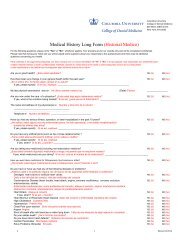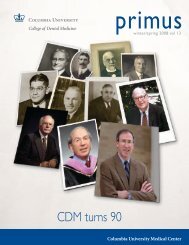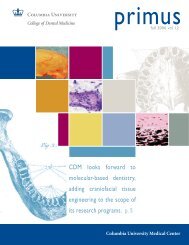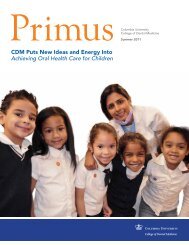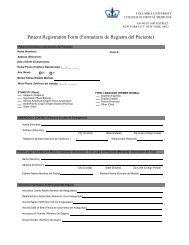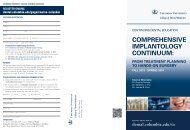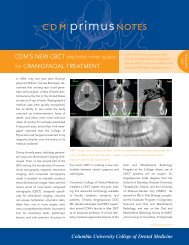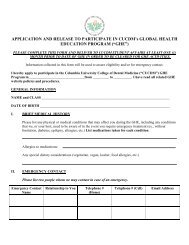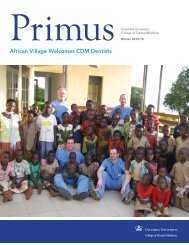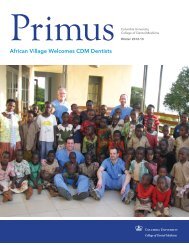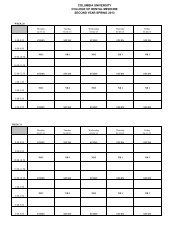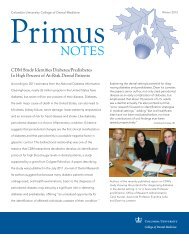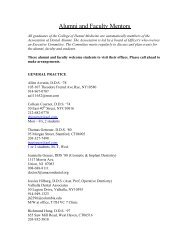Jarvie Journal - College of Dental Medicine - Columbia University
Jarvie Journal - College of Dental Medicine - Columbia University
Jarvie Journal - College of Dental Medicine - Columbia University
Create successful ePaper yourself
Turn your PDF publications into a flip-book with our unique Google optimized e-Paper software.
Volume 56, Spring 2013<br />
Retrospective Case Study on the Damaging Salivary Gland Effects <strong>of</strong> Radioactive Iodine Therapy for Thyroid Neoplasm<br />
Bahareh Goshayeshi, Chelsea Brockway, Louis Mandel*<br />
<strong>College</strong> <strong>of</strong> <strong>Dental</strong> <strong>Medicine</strong>, <strong>Columbia</strong> <strong>University</strong>, NY, NY *Faculty Mentor<br />
Introduction: Thyroidectomy followed by oral administration <strong>of</strong> therapeutic dose <strong>of</strong> radioactive iodine is effective in treating<br />
thyroid carcinoma. A significant portion <strong>of</strong> the radioactive iodine is stored and secreted through the salivary glands. Radiation<br />
damage to salivary glands occurs in an asymmetric pattern and manifests itself as alterations in saliva composition, obstructive<br />
sialadenitis, and/or severe reduction <strong>of</strong> flow rate. Dexamethasone, a long acting glucocorticoid, has anti-inflammatory and<br />
immunosuppressive effects.<br />
Objective: The purpose <strong>of</strong> the present study was to evaluate the impact <strong>of</strong> dexamethasone irrigation on alleviation <strong>of</strong> long-term<br />
effects <strong>of</strong> radiation symptoms.<br />
Hypotheses: 1) Irrigation with Dexamethasone decreases adverse symptoms <strong>of</strong> pain and swelling caused by radioactive iodine<br />
therapy. 2) Patients’ symptoms are dependent upon the dosage <strong>of</strong> radioactive iodine and the time passed since radiation therapy.<br />
Methods: Randomized follow up study <strong>of</strong> 50 patients using the following criteria: history <strong>of</strong> thyroidectomy, iodine radiation<br />
therapy, presented to Salivary Gland Center (SGC) at <strong>Columbia</strong> <strong>University</strong> <strong>College</strong> <strong>of</strong> <strong>Dental</strong> <strong>Medicine</strong> over last 20 years,<br />
complaint <strong>of</strong> obstructive symptoms <strong>of</strong> pain and swelling or dryness, history <strong>of</strong> glands evaluation by means <strong>of</strong> the radioisotope<br />
technetium Tc 99m pertechnetate (TPT). All the patients were <strong>of</strong>fered 3 treatments with dexamethasone irrigations (each<br />
irrigation contains 2cc dexamethasone) by means <strong>of</strong> blunt needle injection technique into the affected ducts, but some refused the<br />
treatment. We were able to reach only 25 patients (m=4, f=21) who were willing to participate in phone study. The phone<br />
interview included verbal consent, reviewing <strong>of</strong> the patient’s chart including salivary gland involvement and TPT result, and<br />
current patient status using ordinal scale (better, same, worse). For each patient, radioactive iodine therapy dose (mCi) and the<br />
date <strong>of</strong> the last dose were recorded to account for the effect <strong>of</strong> these parameters on the results. Statistical analysis was performed<br />
using SPSS s<strong>of</strong>tware for MAC. Data is presented as percentage or numbers. Comparisons between effect <strong>of</strong> dexamethasone and<br />
patient symptoms (result) were made using Chi-square test and is shown in Figure 1. Linear discriminate analysis was used to<br />
assess the relationship between radioactive iodine dose, time, and patient symptoms (result) and is shown in Figures 2 and 3.<br />
Result: Using TPT study, 59% <strong>of</strong> all patients had a history <strong>of</strong> obstructive symptoms in the parotid glands, 6% had symptoms in<br />
the submandibular glands, and 35% had symptoms in both. From the 25 people who met the inclusion criteria, 64% felt better<br />
(Dexa=88%, No dexa=12%), 36% felt the same (Dexa=78%, No dexa=22%), and no patient felt worse than first visit to SGC.<br />
84% <strong>of</strong> patients (study group, n=21) had accepted dexamethasone treatment and 16% <strong>of</strong> patients (control group, n=4) refused<br />
treatment. Patients in the study group were allocated into 3 groups. The first (n=14, 67%) was comprised <strong>of</strong> patients who were<br />
feeling better, the second group (n=7, 33%) was comprised <strong>of</strong> people who believed their symptoms had not subsided. 50% <strong>of</strong><br />
people in the control group reported that their symptoms got better and 50% reported no decrease in symptoms. Irrigation and<br />
post-radiation symptoms (Fig 1): There was no statistically significant difference in symptoms <strong>of</strong> patients that received<br />
dexamethasone compared to control group (Chi-square value=0.405 and asymp. sig= 0.524). No patient ever reported worsening<br />
<strong>of</strong> the symptoms. However, there was a weak association between irrigation and symptoms (phi-coefficient=-.127 and Cramer’s<br />
V= 0.127). 38% patients (n=8) reported immediate relief <strong>of</strong> symptoms after dexamethasone irrigation. Neither increasing<br />
radioactive iodine dose nor shorter time periods after radiations were associated with worsening <strong>of</strong> the symptoms (canonical<br />
correlation= 0.391, chi-square=3.651, P value= 0.161). The radiation dose has a greater impact on resulting symptoms (Function<br />
coefficient=0.682).<br />
Discussion: Alterations in salivary gland function following radioactive iodine therapy has been reported. Serous parotid salivary<br />
glands are more susceptible to radioactive iodine than the mucous submandibular glands, and, therefore, most side effects are<br />
present in the parotid gland. Radiation damage to salivary glands is irreversible since these cells divide rarely, and therefore no<br />
drug can cure the adverse effects. Salivary obstruction combined with oral dryness and discomfort developed in all patients in this<br />
study. In the present study, dexamethasone was <strong>of</strong>fered to patients that reported adverse effects <strong>of</strong> radioactive iodine therapy to<br />
decrease subjective symptoms. Even though the direct effect <strong>of</strong> dexamethasone treatment on patient symptoms cannot be<br />
observed, the clinical importance <strong>of</strong> this medication cannot be ignored due to the fact that immediate relief was reported in many<br />
patients. Surprisingly, this study provides controversial evidence for direct association between symptoms and either radiation<br />
dose or time. There were many barriers to this study, not the least <strong>of</strong> which was recruitment <strong>of</strong> adequate patient numbers to<br />
provide powered results and inclusion <strong>of</strong> patients who had received different dexamethasone dose to conduct a dose-dependent<br />
study.<br />
Chelsea Brockway was supported by a <strong>College</strong> <strong>of</strong> <strong>Dental</strong> <strong>Medicine</strong> Pre-Doctoral Summer Research Fellowship.<br />
43



